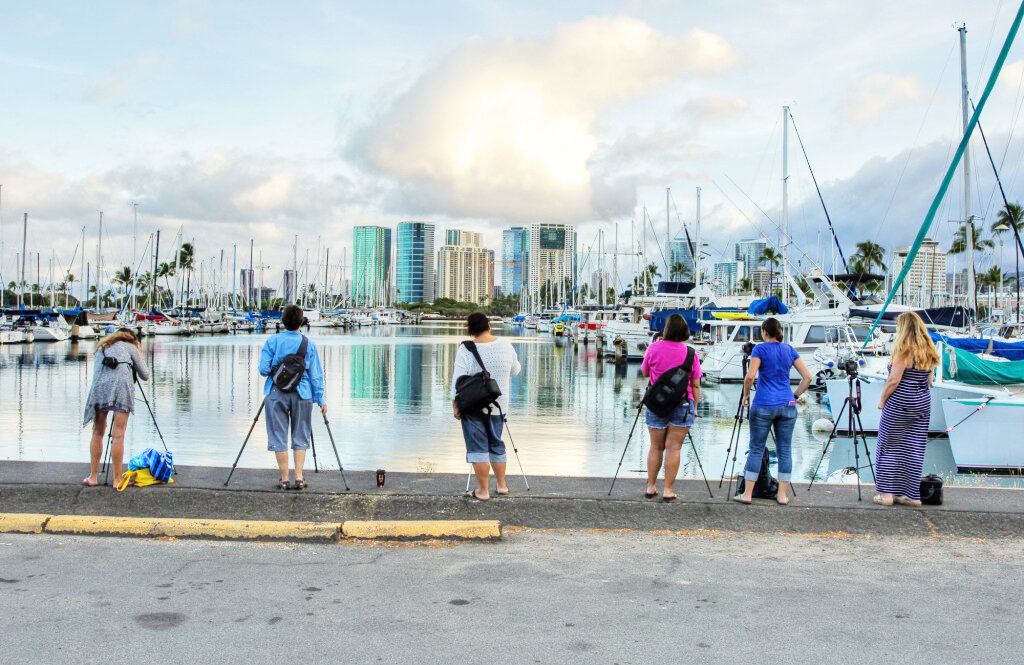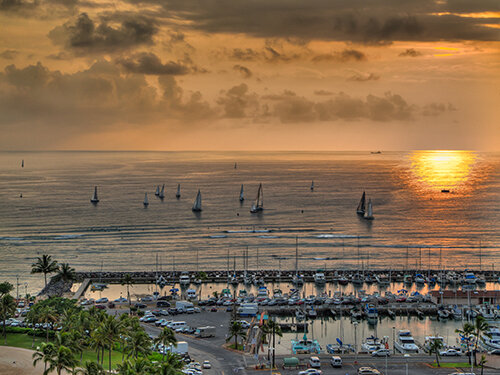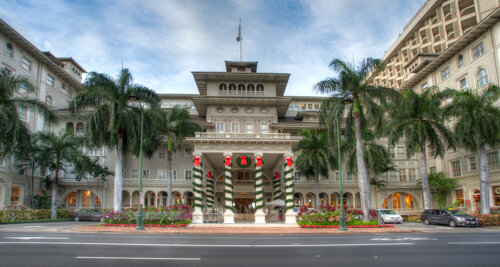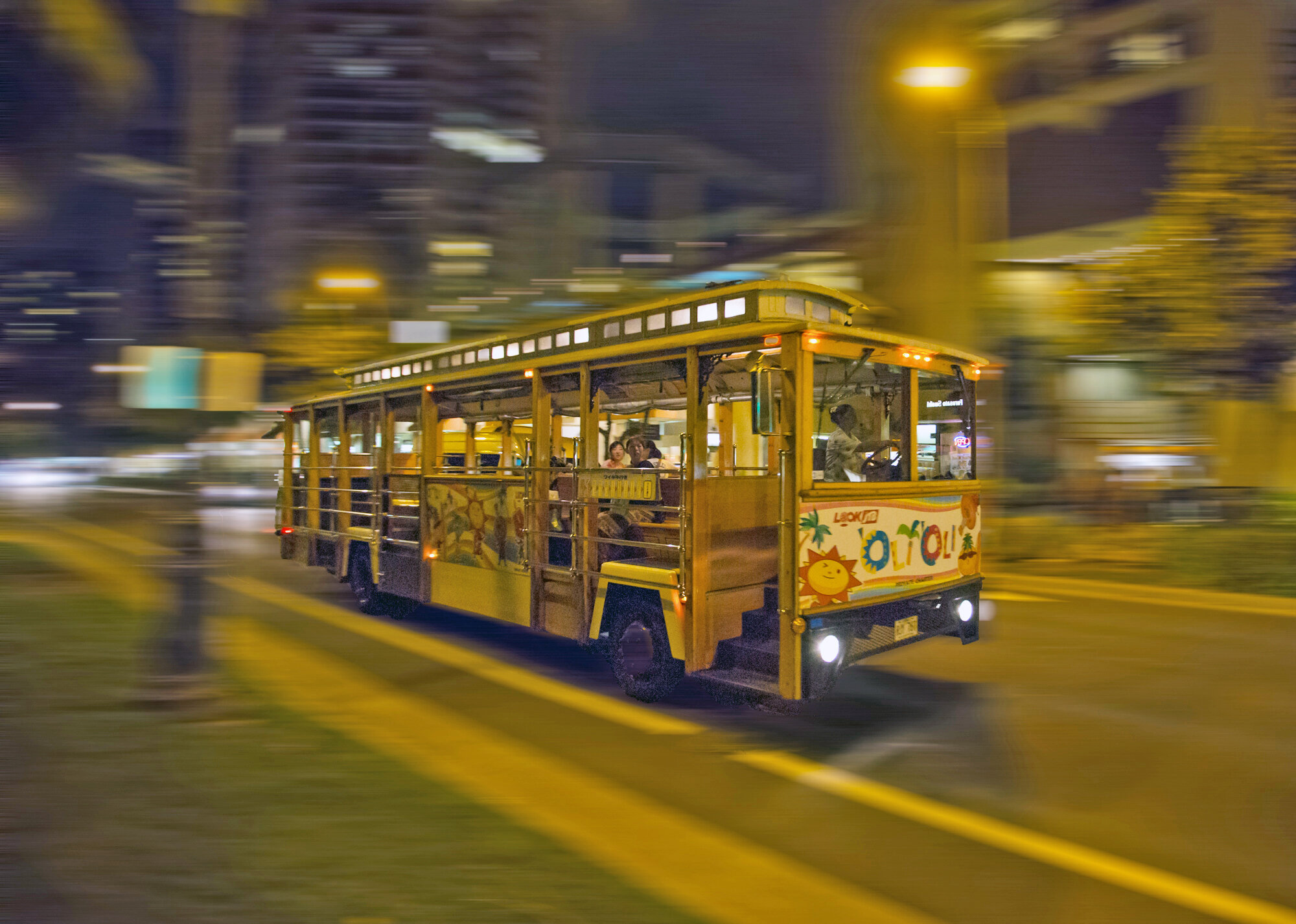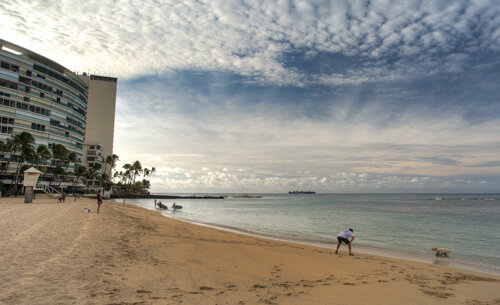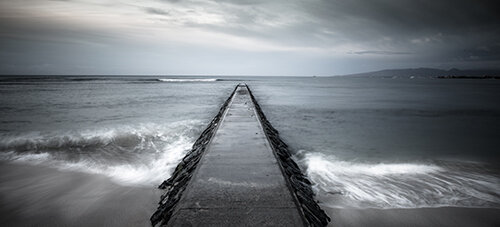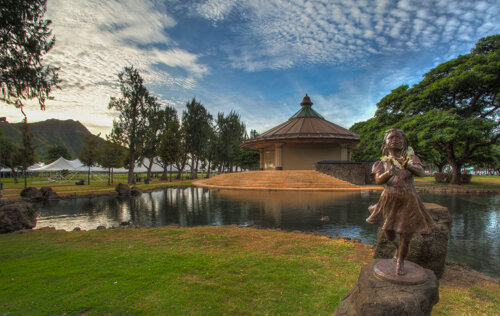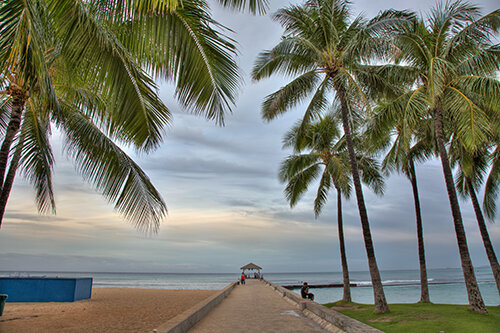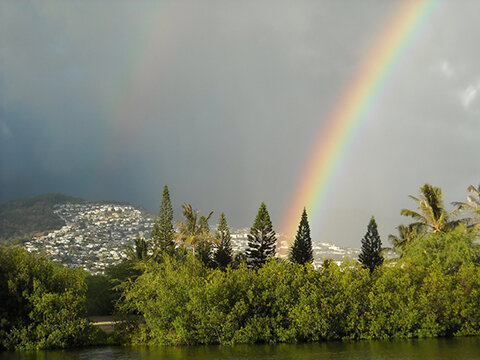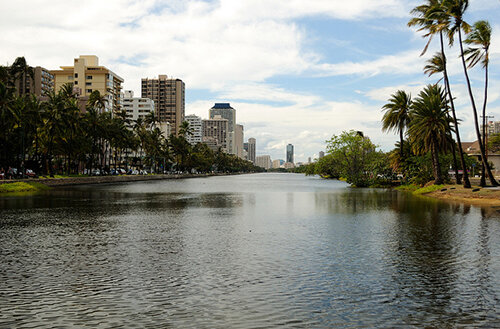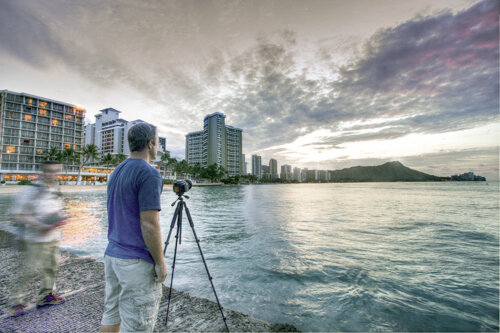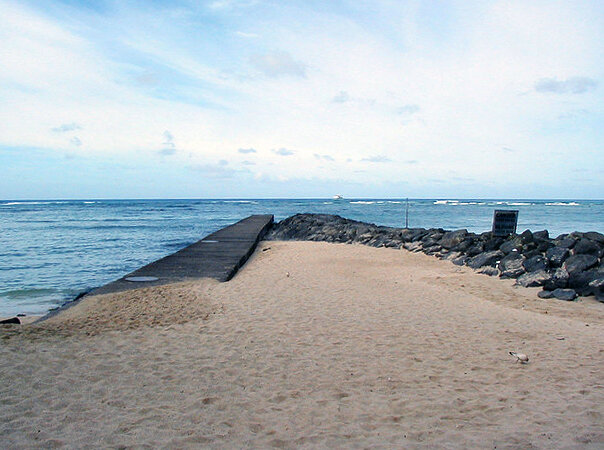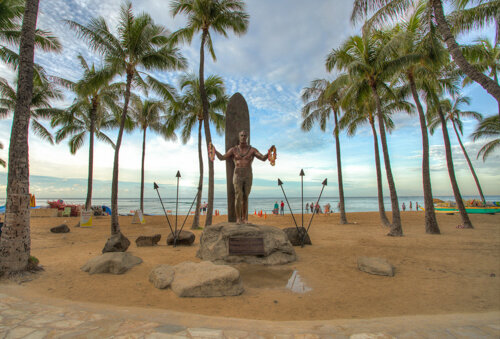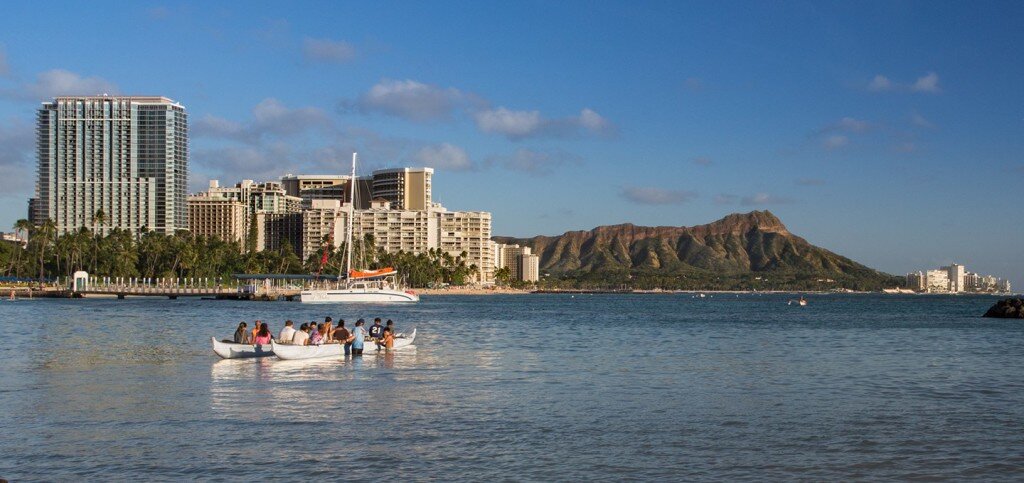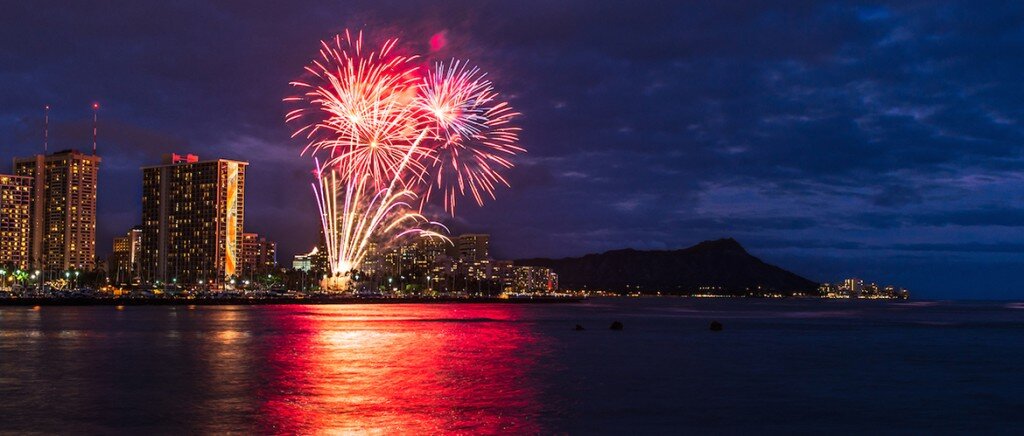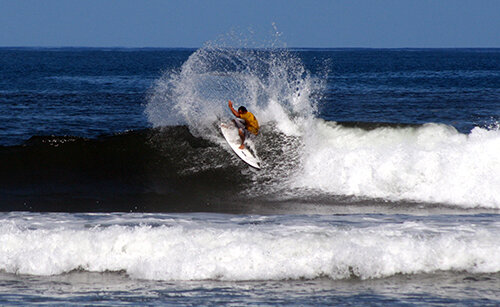Top 10 Best Places to Take Pictures in Waikiki
The allure and charm of Waikiki has attracted the masses from around our world and it is evident that everyone who visits likely has a camera around their neck. How and where do you capture the character, beauty, romance, and aloha of such an iconic place? We sat down to interview one of Oahu’s top photo guides, Alex Wilson, owner of Oahu Photography Tours who shares his favorites. Alex reminds us that, “This day is yours and yours alone, so get out and make it happen.”
Here are the top 10 best places to take pictures in Waikiki.
#1. Magic Island
Sunset on Magic Island is amazing! Arrive early and walk around, then make your way to the Diamond Head side to watch the sailboats depart and enter the harbor. If you are lucky enough to be there on Fridays, you’ll want to take advantage of the Friday night firework show taking place every Friday evening shortly after sunset (hosted by the Hilton Hawaiian Village).
Setting up at Magic Island with a camera and hopefully a tripod, you will be welcomed with a natural iconic background of Diamond Head and the Waikiki coastline at sunset. Then when the fireworks go off, you will have an amazing backdrop of Waikiki plus brilliant reflections on the water! A best time to photograph this is in the summer (when the sun sets a bit later) because Diamond Head can still be seen during the fireworks. With gradient hues above Diamond Head, Waikiki’s famous skyline, and the amazing display of fireworks, anyone with a camera can guarantee an awesome shot from Magic Island.
If you would like to schedule a sunset and Friday night fireworks or full-day photo tour with pick-up and drop-off provided, check this out . . .
#2. The Ilikai Marina
What every visitor must see is, of course, a Hawaiian sunset. You could try to do this from a number of spots, but if you prefer to frame it at place of great nostalgia and significance while utilizing some great elements, make a point to get out to the Ilikai Marina.
You’ll find an open horizon, calm and reflective waters, and great silhouettes of sailboats all around – which makes for a really neat shot! You might get some interesting cloud patterns in your reflections, and certainly a “rainbow sherbet” of colors.
Allow time to meander along the marina and be mesmerized by this scene! You are standing at a historic place. The Ilikai was the first luxury high rise hotel in Hawaii when it opened its doors in 1964.
#3. The Moana Surfrider
Besides the ocean and mountain scenery, Waikiki’s lights and structures can be great subjects in their own right. One favorite spot is on Kalakaua Avenue across from the legendary Moana Surfrider Hotel.
The Moana is referred to as the “First Lady of Waikiki,” since this oceanfront resort introduced the world to Hawaiian hospitality in 1901.
Try long exposures with a wide-angle lens, standing on across the street (at the corner ABC store) pointing towards the hotel. A bus may go by (or the Waikiki trolley); a bunch of cars will go by, along with a zillion people crossing the street…
All that movement in contrast with the stoic, faithful presence of The Moana makes for a pretty cool image indeed. During the holiday season, the hotel pillars are decked out with decor and lights, for an extra brilliant snapshot.
#4. Behind the Hilton Hawaiian Village
Moving along the strip, let’s not forget the spot behind the Hilton Hawaiian Village itself (where the fireworks shoot off from on Friday nights). If you situate yourself out on the beach, far away enough past the lagoon, you’ll frame the iconic Rainbow Tower on the left and Diamond Head in the distance. Again, this could be for a fireworks shot, rising moon shoot, or a classic sunset type of shot.
Tip: This is listed in our article on the best spots on Oahu for a sunrise!
Make sure you arrive 30-45 minutes before sunrise to capture the reflections from the Waikiki hotel lights.
#5. Kaimana Beach
Waves splashing at high tide, lots of silhouettes and surfers, all engaged with the colors at dusk once again… Doesn’t that sound like a scene to sink into?
At Kaimana Beach, you’ll get one of the best combos of locals and tourists merging into the elements Waikiki has to offer. Remember, you don’t always need to fight the people, by trying to get them out of your shot. Use them to your advantage, as subjects in your photo – i.e. that couple gazing off into the distance, or a surfer with board in hand pausing to observe the tides.
So, set up the tripod and see what comes across your frame. Freeze those moments as a part of your scene, embellished with ocean splashes coming up against the rocks! Then, as you wait for the next set of waves…something else interesting might happen.
#6. Kapiolani Park Bandstand
For anybody that loves photographing wildlife, or anything out of the ordinary for that matter, there is a little known occurrence near the bandstand at Kapiolani Park (the huge open space on the east side of the Waikiki strip, with lots of soccer fields and families picnicking).
Around dusk (you’re probably figuring out that this is one of the key times to be out photographing Waikiki) – suddenly hundreds of parakeets will shoot out of the banyan trees. They’re not huge birds, but they’re fast, so nobody really pays attention. But this is a shot worth grabbing that probably no one else has thought of.
#7. Behind the Ala Wai Canal
Hardly anyone thinks about photographing the Ala Wai Canal, since most are busy exploring the Kalakaua and Kuhio Ave strips. But if you do get up there (bordering the north side of Waikiki), you’ll discover some really neat reflections of buildings, and an occasional display of vivid rainbow making its way down from the mountain backdrop.
Standing on the south side of the canal, shoot towards the mountains. A good place to be positioned is towards the east side, near the padding club.
Also, see what the clouds are doing behind the mountains. Hawaii’s trade winds create the most fluid cloud movements – they can literally change by the minute. Capture one of those moments and hold onto it.
In any situation, patience is key to create that “picture-perfect scene” you’re envisioning. It’s all about knowing the elements you’ve got to work with, then waiting for it to come together. It may not happen that hour, or that day, but a persistent photographer eventually gets what he’s looking for…
#8. Pier Behind the Outrigger Reef Hotel
Another summer catch is found at the pier behind the Outrigger Reef Hotel. (Ask the hotel staff if you’re unsure of where you’re going.)
Only around June-July, you’ll have a chance of getting a shot of the full moon coming over the top of Diamond Head. It’s quite the surreal moment you’d imagine on a postcard – but remember, it ONLY happens around June-July! Check tidal calendars to see when the moon will be rising that night, and be sure to set up early.
#9. The Duke Kahanamoku Statue & Surfstands
Right next to the Moana Surfrider, you’ll find one of Hawaii’s most famed surf breaks as well as the founder of surfing himself – Duke Kahanamoku – or should we say, a bronze statue of The Duke welcoming you to Waikiki with open arms. He carried the essence of Aloha around the world, and his poise and nobility is preserved in that figure of him standing in front of the place he loved.
Get close up, tighten in your frame, and create your portrait of Mr. Aloha, who is often laden with colorful flower lei wrapped around his neck and arms from admirers around the world. Then try a wide-shot and long exposure of him, in contrast to the hustle and bustle of the beach scene behind. Around 8-9am is great, before the sun hits him too strongly, and when people are starting to come out to play.
Of course, you can’t go home without capturing the longboard line-up (rows of lockers owned by locals) made for gliding on mellow Waikiki waves. Again, try different angles. If you get close up, you could frame an interesting macro shot, which will cause your viewer to pause and wonder what it is – a jail cell? Of surfboards?
#10. Anywhere You Are!
Finally, don’t be picky. JUST BE ANYWHERE YOU ARE and let yourself focus on what’s in front of you – an intersection, a lobby, a building with cloud shadows, skylines, or whatever contains movement.
Have a ball with a time-lapse, which most cameras have as built-in settings these days. Take photos every 2-3 seconds or so over the course of even a couple hours! When you compile tthem into a video clip, you’ll get an amazing sequence, guaranteed.
e.g. Check out that Udon restaurant on Kuhio Ave with a constant line-up (#1. It must be good for lunch. #2. You can take a time lapse while your family waits in line for you.
So, the moral of the story is to get out at anytime AND at key times, especially dawn and dusk. Get out early if you want to see the people wake up with city. Meet the locals. Visit the Waikiki beach boys setting up near The Duke statue, and take some candids of them. They’d be happy to share a bit of their old-time stories too.
In the end, Alex encourages us to JUST HAVE FUN WITH NO EXPECTATIONS. Go and achieve with whatever is thrown at you – that’s part of the joy of photography, and the attitude that makes or breaks your shoot. What you go home with is what you get – and be proud of your adventure that you’ve tailor-made for your day….
Mahalo & Aloha!
More info regarding dates, times, and prices for daily photo tours can be found here:

